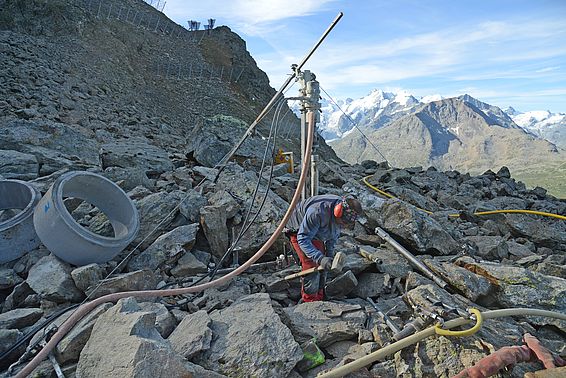16.02.2023 | Christine Huovinen | News SLF
The SLF Permafrost research group is monitoring ground temperatures in permafrost and using new methods to measure the increasing water content caused by climate change, allowing for improved assessments of natural hazards and future water availability in the Alps.
The SLF showcases the research groups of the Climate Change, Extremes and Natural Hazards in Alpine Regions Research Centre CERC, in no particular order. Founded in 2021, the CERC is sponsored by the Canton of Grisons and the Swiss Federal Institute for Forest, Snow and Landscape Research WSL and is supported by ETH Zurich. It is part of the SLF in Davos.
Although it has been known for a while now that permafrost is warming due to climate change, even experts are astonished at the speed at which the thawing is occurring. Marcia Phillips, who has been using borehole measurements to monitor the state of permafrost in Switzerland since 1996, says: "There have been huge changes in permafrost, with heat waves happening almost every other year since 2015. Ground temperature has risen sharply, leading to ice loss and major slope movements in some areas." For example, rock glaciers (a mixture of debris and ice and a typical phenomenon in Alpine permafrost regions) are now moving downhill much faster than they were 20 years ago. As a result, material is more likely to be released from their often steep fronts, which in turn can lead to increased rockfall or debris flows.
New measurement method for permafrost regions
While the assumption made by scientists has been that rock glaciers contain more water due to thawing and so creep more quickly than in the past, up to now there has been a lack of empirical knowledge about the situation. Phillips, head of the SLF Permafrost research group, part of CERC, wants to change this. Working with her team on the Schafberg above Pontresina, she has tested a novel combination of methods for the first time in permafrost, namely combining temperature measurements with water-pressure measurements and surveys of the electrical resistivity between two boreholes – data which allowed the researchers to record changes in specific resistivity over five metres on a daily basis and at a high spatial resolution. By combining these techniques, the team showed, for the very first time, that there are significant differences in water-/ice ratios in rock glaciers over a small area, despite little variation in ground ice temperatures, which are close to 0 °C.
Water holds the key to understanding
The team's methodology and results have recently been published in The Cryosphere, giving Phillips extra encouragement to pursue her research: "I believe that the volume and flow of water in permafrost hold the key to understanding many slope movements, including deep-seated ones. Given the success of the Schafberg measurements, we will now apply the same approach to other rock glaciers in Switzerland as part of a Swiss National Science Foundation project. We are also studying the role of water in unstable rock walls for another project. With this research we hope to provide a basis for explaining slope movements and rock avalanches and to make it possible to more accurately predict future water availability in the Alps."
Contact
Links
Publications
Copyright
WSL and SLF provide the artwork for imaging of press articles relating to this media release for free. Transferring and saving the images in image databases and saving of images by third parties is not allowed.
